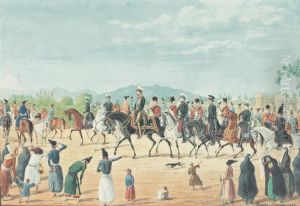Rodolphe Fraehn Paintings
Christian Martin Joachim Frähn, known as Rodolphe Fraehn, was a German-Russian orientalist and numismatist born on July 5, 1787, in Rostock, Mecklenburg-Schwerin (now Germany). He was a pioneering figure in the study of Islamic numismatics and made significant contributions to the field of Oriental studies during the 19th century.
Frähn's academic journey began with studies at the University of Rostock, after which he continued his education at the University of Göttingen, a prominent institution for Oriental languages and literature at the time. His interest in the East was likely sparked by the intellectual climate of the era, which saw a growing European fascination with Oriental cultures and languages.
In 1811, Frähn moved to St. Petersburg, Russia, where he was appointed associate professor of Arabic, Persian, and Tatar languages at the Imperial Academy of Sciences. His career flourished in Russia, and he became a full professor in 1819. Throughout his tenure, he amassed a significant collection of Islamic coins and published extensively on the subject. His works included 'Numi Asiatici' and 'Notice d'une collection de monnaies Arabes et Persanes', which are considered foundational texts in the field of Islamic numismatics.
Frähn's scholarship was not limited to numismatics; he also contributed to the understanding of Central Asian history and geography. He was among the first scholars to decipher ancient inscriptions from Central Asia, paving the way for future studies. His contributions to Russian academia were recognized by his appointment as a State Councillor in 1837.
Rodolphe Fraehn's influence extended beyond his immediate field as he corresponded with other Orientalists and shared his findings with scholars across Europe. His dedication to the study of the East was evident in his extensive personal library, which contained numerous rare manuscripts and books in various Oriental languages.
Frähn passed away on September 16, 1850, in St. Petersburg. His legacy lived on through his extensive publications and the rich collection of coins and manuscripts he left behind, which continued to serve as valuable resources for scholars of Islamic art, numismatics, and Oriental studies.
